|
 Heimiomyces neovelutipes Heimiomyces neovelutipes
SynonymsCrinipellis velutipes
Collybia neovelutipes
Xeromphalina tenuipes
BiostatusPresent in region - Indigenous. Non endemic
Images (click to enlarge) | 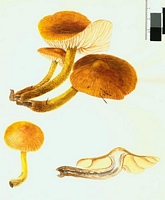
Caption: Watercolour
Owner: G.M. Taylor | 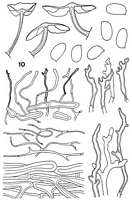
Caption: (ZT, 71/172): carpophores, spores, cheilocystidia, caulocystidia, cuticle | 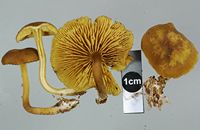
Owner: J.A. Cooper | 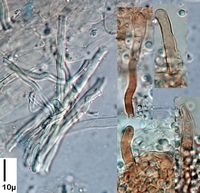
Caption: cap elements (KOH)
Owner: J.A. Cooper | 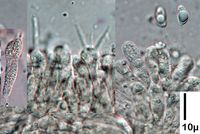
Caption: basidia (KOH)
Owner: J.A. Cooper | 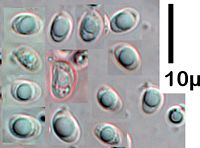
Caption: spores (KOH)
Owner: J.A. Cooper |
Article: Stevenson, G. (1964). The Agaricales of New Zealand: V. Kew Bulletin 19(1): 1-59.
Description: Pileus 2.5-4.5 mm diam., ochraceous with vinaceous striations, smooth or with sparse ochraceous fibrils towards the centre, plano-convex with depressed centre to shallow concave; flesh ochraceous, somewhat water-soaked. Gills adnexed, ochraceous, moderately distant, deep. Stipe 3-5 cm x 3-5 mm, luteous, covered with deep velvety tomentum, hollow, tough. Spores 8 x 4-4.5 µm, amyloid, thin-walled; print white. Cheilocystidia 30 x 5 µm. Hyphal endings on stipe amyloid, 3-4 µm diam., thick-walled, lobed or branched. Cuticle of closely woven hyphae 3-5 µm diam., with some thick-walled, amyloid hyphal hairs.
Habitat: On fallen rotting log, Waikanae, 1.1.1951, Stevenson (type).
Article: Horak, E. (1971). A contribution towards the revision of the Agaricales (Fungi) from New Zealand. New Zealand Journal of Botany 9(3): 403-462 (http://www.rsnz.org/publish/abstracts.php).
Notes: Crinipellis velutipes Stevenson (29 D) Doubtful species. Type material sterile.
Article: Horak, E. (1980) [1979]. Xeromphalina and Heimiomyces in Indomalaya and Autralasia. Sydowia 32: 131-153.
Description: Description of personal collections from Papua New Guinea:
Pileus-50 mm, convex, plane or concave with broad obtuse umbo, campanulate; yellow-brown at disc, yellow towards strongly striate margin; dry, smooth to granulose becoming minutely velvety, strongly hygrophanous. Lamellae (L 8-10, -3) rather distant emarginate, subdecurrent with tooth, ventricose, up to 10 mm wide, often intervenose; yellow, with reddish brown tint in mature specimens, edge concolorous, even. Stipe -40 x-4 mm, cylindric, equal, central; yellow-brown; dry, entirely pruinose to velvety, hollow, tough, veil remnants absent, single in groups. Context gelatinous. Odour and taste acidulous. Spore print white.
Spores 7-8 (9) x 3.5-4 (5) µm, elliptic, smooth, hyaline, amyloid, thin-walled. Basidia 25-35 x 5-6 µm, 4-spored. Cheilocystidia 25 – 40 x 3-6 µm, branched with irregular, rod-like projections, membranes hyaline, thick-walled. Pleurocystidia none. Caulocystidia irregularly branched near tips, membranes thick walled, yellow-brown or rust brown (KOH). Cuticle a trichoderm or palisade of fasciculate, projecting, cylindric or clavate terminal cells (pilocystidia), apically with short antler-like projections, membranes thick-walled, hyaline to rust brown, sometimes with yellow-brown plasmatic pigment; intermixed with ovoid to polymorphous cells with thick-walled and strongly refractive walls. Subcutis divided into 2 well defined layers: a) strongly gelatinised, hyaline, entangled hyphae (1-3 µm diam.)-below epicutis; b) irregularly arranged, cylindric, often branched hyphae (up to 20 diam.) with thick-walled, strongly refractive, gelatinised membranes. Clamp connections present.
Habitat: On rotten wood in broad-leaved forests.-Papua New Guinea.
Notes: According to all morphologic data observed on H. neovelutipes (HONGO) and H. atrofulvus (STEVENSON) these two taxa are undoubtedly closely related to the polymorphic ( ?) and widely distributed H. tenuipes (SCHWEINITZ) SINGER (PEGLER 1977). After examining type material (and additional collections made in the USA) of the latter fungus I came to the conclusion that H. neovelutipes and H. atrofulvus can be considered as geographic micro species distinctive enough to be separated from H. tenuipes proper. Under these circumstances I do not follow HONGO (1976) who considers his H. neovelutipes now as a further synonym of H. tenuipes. Unfortunately the fragmentary condition (HORAK 1971) of the type material prevents the final decision where to accommodate the New Zealand Crinipellis velutipes STEVENSON (1964). Macroscopically all details seen on the coloured plate no. 9 are strongly resembling H. neovelutipes (HONGO) which I collected myself twice in Papua New Guinea. It is very likely that C. velutipes STEVENSON is conspecific to this species, however, fresh material is needed to resolve this problem.
|